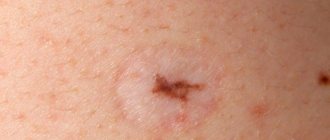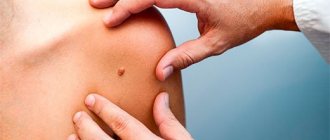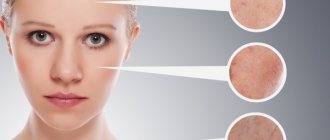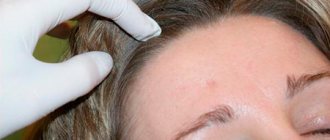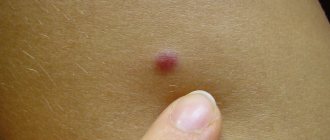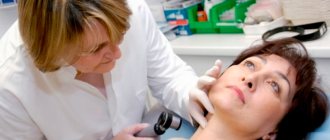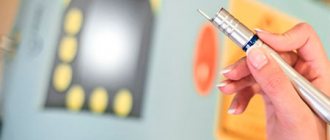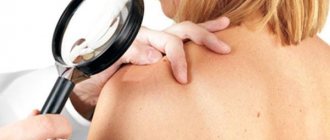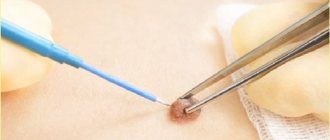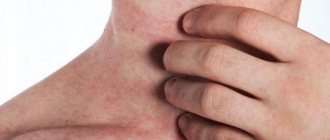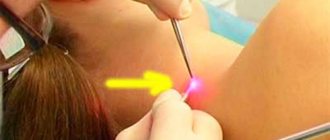A crust after mole removal is a natural sign of tissue healing after surgery. Minimally invasive surgical methods are advisable for getting rid of age spots and nevi. The duration of the postoperative period depends on the characteristics of the formation - size, shape, localization, method of removal - excision, laser, cryodestruction, radio wave knife Surgitron. Usually it ranges from several days to a month.
How long does it take to heal?
The duration of tissue healing is of particular concern to patients. After all, after laser removal of a nevus, redness and visible swelling are observed on the skin, and instead of the mole itself there is a crust. This reaction is completely normal.
The healing period of a wound after laser exposure depends on the size of the formation and the degree of its penetration into the epidermis. But even if large nevi were removed, the tissue does not recover for too long - within 2-4 weeks.
In the first months after removal of a mole, a small pit will remain on the skin, which will then smooth out and become a light spot. Approximately three months after the intervention, the color of the new skin will even out.
Diagnostic process
Before prescribing treatment, the doctor must conduct a medical examination of the patient. During the process, the doctor examines the problematic pigment spot. Using special devices, he feels bleeding moles and analyzes the general condition of the formations. During dermatoscopy, the doctor will identify any pathological processes and changes. There is no need to be afraid of diagnosis, since all procedures do not cause pain to the patient. In the process of studying nevi, it is prohibited to perform a biopsy; only histology is allowed, which is performed only after surgical removal of the nevus.
When does the crust fall off?
The dark crust on the surface of the skin is nothing more than a scab - it is formed by coagulated blood and dead tissue. Such cover is very important for the wound; it prevents the penetration of infectious agents into it and ensures easy growth of new tissue.
On average, the crust disappears from the epidermis 7–9 days after the intervention. In its place remains very delicate pink skin. Of course, you should never pick off the crust yourself.
How to care for a removed nevus?
For complete skin restoration and problem-free healing, it is very important to ensure proper care of the wound left after laser exposure:
- Do not touch the wound again, protect it from all kinds of traumatic effects and damage. Clothes should not rub the skin, and accidental scratching with nails should also be avoided.
- The wound must be protected from accidental contact with creams, detergents and other similar substances. Treatment is carried out in accordance with the doctor's recommendations.
- It is extremely important to protect the wound from ultraviolet rays, because they are quickly absorbed by young skin cells, which causes pigmentation (a spot will appear instead of the removed mole). Doctors usually recommend lubricating the epidermis with creams with a high ultraviolet protection filter (at SPF-50 level), and also limiting the time spent in the sun. Such recommendations remain relevant for a month after removal; they must be followed at any time of the year.
- You cannot visit the pool or sauna for two weeks after the intervention. Otherwise, the risk of infection increases several times.
- If the wound is located on the face, you should not use decorative cosmetics until complete healing (the scab falls off).
- Do not apply any alcohol products (for example, iodine, etc.) to the wound. Such substances can injure delicate skin and cause burns or irritation.
- It is important to protect the wound from temperature changes in the first few weeks after the intervention.
It is especially important to strictly follow the care recommendations if the wound is on visible parts of the body. After all, a pigment spot or scar can become a serious cosmetic defect.
Popular methods and care
Currently, there are several methods for eliminating moles; the choice is usually made by a specialist. The doctor takes into account many factors - localization, likelihood of malignancy, area of skin damage.
Laser
The most precise impact is achieved when using a laser. This method is currently the most optimal. Experts highlight a number of positive aspects of this manipulation:
- local anesthesia makes the procedure virtually painless, even a child can easily endure it;
- duration is only 5-10 minutes;
- narrowly targeted beam exposure and the ability to control the depth of action prevent damage to surrounding tissues;
- soft and layer-by-layer removal of the nevus occurs;
- no bleeding;
- There are almost never any traces left after manipulation;
- minimum rehabilitation period (no more than 1-2 weeks).
What to treat for healing?
After removing a mole with a laser, the doctor should give recommendations on how to treat the wound. Typically, a freshly prepared solution of potassium permanganate (known as potassium permanganate) is used for this.
To treat the wound, you need to use a light pink liquid; it is important that there are not even tiny crystals of potassium permanganate in it (otherwise, tissue burns may occur). It is worth noting that many modern doctors do not insist on using antiseptics after removing a mole. They simply advise not to touch the wound.
What to apply?
To prevent the appearance of scars and speed up recovery, the following can be used:
- Panthenol. This is a cream based on dexpanthenol (a derivative of vitamin B5). It effectively moisturizes the skin and promotes its rapid regeneration. You can smear your skin with Panthenol several times a day.
- Contractubex. This ointment is widely used to prevent the appearance of scarring on the skin. It will help the trace of the removed mole to disappear as quickly as possible. Contracutubex must be used in accordance with the instructions (several times a day).
- Actovegin. This is a gel product that stimulates recovery processes and ensures rapid healing of postoperative wounds. Its use also reduces the risk of scars.
- Dermatix. This is a silicone-based gel that helps reduce the risk of scars, deeply moisturizes and softens the epidermis. Its use also helps eliminate itching, neutralize burning and redness, which are natural symptoms of normal skin healing.
Creams, gels and ointments can be used only after the scab has naturally fallen off the wound. Before this, their use is inappropriate and may even be harmful.
Consequences of removing moles with nitrogen
The procedure for removing nevi using liquid nitrogen is called cryodestruction. There are usually no guarantees with this method, so results may vary.
The fact is that when treating tissues with nitrogen, it is impossible to accurately calculate the depth of penetration of the substance. This often results in incomplete removal of the lesion, so sometimes additional treatment may be required.
The healing stage after cryodestruction is long, and after it there are traces of the burn - scars. Tissue restoration takes a long time, several months.
During the removal process, healthy tissue may also be accidentally damaged. Such damage will look like a burn, and its healing will take longer than usual.
The only advantage of this method is its simplicity and low cost.
[6], [7], [8]
When can you wash?
Usually, doctors strongly do not recommend soaking the crust on the wound until it falls off naturally. Although some dermatologists and cosmetologists allow quick hygiene procedures (shower) in the first days after the intervention. Exact recommendations about when you can wet the wound after laser removal of a mole are given by the operating specialist.
If showering is allowed in the first days, it is important to remember:
- The wound should not be wetted for a long time, much less direct streams of water at it.
- The skin should not be rubbed with a washcloth or washed with usual products.
- After a shower, do not rub the wound with a towel. You can only blot it carefully.
- Immediately after a shower, it is important to treat the healing skin with a product recommended by the doctor (the same solution of potassium permanganate).
Full water procedures can be carried out only after the scab has safely fallen off the wound. Excessive hydration before this point can lead to disruption of the healing process, infection and other unpleasant consequences.
What to do if it doesn’t heal for a long time?
Usually, with proper care of the wound after removal of a nevus, healing proceeds without problems. Any disturbances in the normal course of recovery processes are a reason to visit a doctor. If you ignore unpleasant symptoms, you may face serious consequences.
A lump has appeared
If a lump or lump appears on the skin after laser removal, it is better to play it safe and consult a doctor. Such a reaction can be completely natural and occur during the normal course of recovery processes. But sometimes she warns about:
- Scar formation.
- Development of the inflammatory process (in this case, redness may additionally be observed, and soreness may appear).
- Progression of oncology.
A growth that hurts, becomes scaly, ulcerates, or changes color should be of particular concern.
The surgical site is painful or itchy
Some soreness is completely natural in the first 1-2 days after removal, and it is easily relieved with analgesics. But if the removal site hurts later, the discomfort is quite pronounced and even more so is accompanied by some visual changes, you should see a doctor. Such a symptom may indicate the addition of inflammation or even the development of cancer.
Itching is also considered a natural symptom. But if it is combined with pain and does not go away, this indicates insufficient professionalism of the doctor. Such symptoms are possible with burns of healthy skin around a removed nevus or in the deep layers of the dermis.
Some patients experience that the scar hurts even several weeks or months after laser removal. A similar situation can be provoked by constant pressure on the scar, for example, from a piece of clothing. If there is no visible explanation for the pain, it is better to discuss its causes with your doctor.
The temperature has risen
During recovery after laser removal of a nevus, a slight increase in general body temperature to subfebrile levels (about 37 °C) may occur. This is the body’s reaction to the intervention performed; well-being returns to normal literally within a day. But sometimes temperature is an alarming symptom:
- If the general body temperature rises and the wound becomes red and swollen, you should immediately go to the doctor. Such symptoms indicate the addition of an infection and require immediate antiseptic treatment, as well as the use of antibacterial drugs.
- If the wound itself and the skin around it become hot, you should also hurry up and visit a doctor.
If the healing processes are not disrupted, but the body temperature rises, this may be due to the development of ARVI or other health problems that are not related to the intervention performed. In such a situation, you just need to carefully monitor your well-being and treat yourself according to the existing symptoms.
The wound is festering
The appearance of discharge similar to pus is a very alarming symptom that indicates the addition of an infection. This development of events can be explained by insufficient care and is accompanied by visible redness of the skin near the removed nevus, noticeable discomfort and a local increase in temperature.
Having discovered the discharge of pus from the wound, you need to treat it with a solution of potassium permanganate and consult a doctor. Further treatment will most likely involve the use of antibacterial ointments and anti-inflammatory drugs, as well as regular use of antiseptics. There may be a need to take antibiotics internally - in the form of tablets.
Inflammation after nevus removal increases the risk of scarring.
